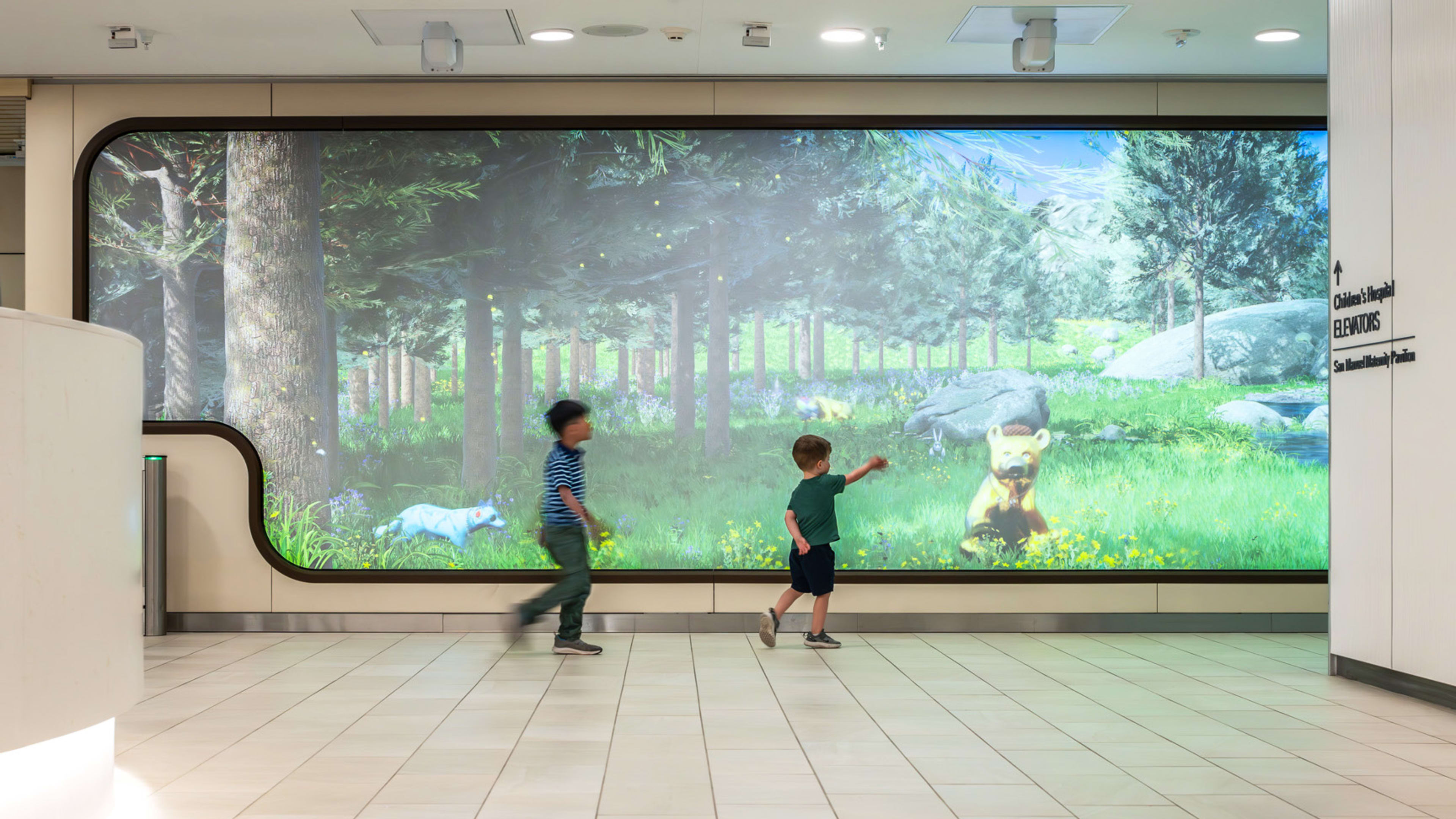A rainbow-fur raccoon wearing a necklace made of fishbones is walking along the hallway of Loma Linda University Children’s Hospital. And it’s not alone. There’s also a plaid-colored bear, a deer wearing sunglasses, and a rabbit with a hat made from a lily pad. This unexpected collection of bedazzled animals congregating outside of the hospital’s main lobby is part of Loma Land, a unique new interactive experience designed for children facing the sometimes terrifying prospect of a hospital visit.
Loma Land is a digital wilderness set on a 60-foot-wide screen where children can create avatar animals that accompany them on their walk towards their procedures and patient rooms. With simple interactive touchscreen displays, children create and personalize their own animal before setting it free to wander and interact with other animals in a vast digital scene set in a forest. It’s a bit of creative fun intended to engage young visitors and patients at the hospital and, hopefully, help reduce some of the anxiety caused by having to be there in the first place.
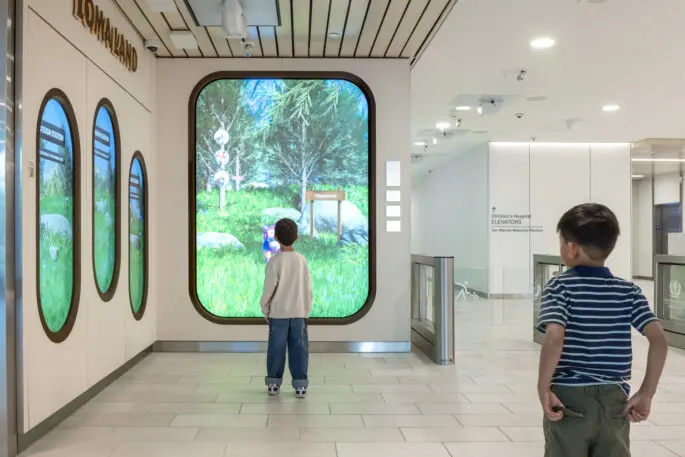
Located in Loma Linda, California, just outside San Bernardino, the hospital is the region’s main Level 1 trauma center, which means it handles some of the most serious medical cases. The hospital system sought to create Loma Land as a calming way to bring children into a space that can be tense or even scary.
“We have a population that is coming to us at very stressful times in their lives,” says Rachelle Bussell, senior vice president of advancement for Loma Linda University Health, which runs the hospital. “We believe that whole person care really makes a difference in healing.”
Loma Land was created by ESI, an experience design studio that’s part of the architecture firm NBBJ. The installation centers around simple multi-screen interactions where children can create and customize creatures from a menu of options, including animal type, coloring, and visual flair. Another screen is used to show what the completed creature looks like, and also serves as a space where children can set their animal loose. That brings their creature onto the 60-foot-wide digital screen that features an animated forest, where they interact with other creatures created by other children visiting the hospital. Lining the corridor that leads to the elevators, the screen becomes part of a child’s entrance into the hospital complex, a soft bit of digital engagement before they head to a clinic or ward.
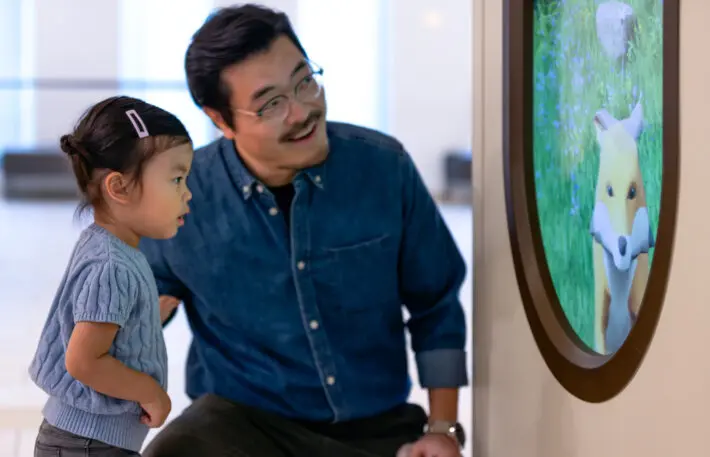
The intent was to create “something that was creative, and would make them feel like they’re welcomed into a community,” says Emily Webster, the project’s lead experience designer. “Subconsciously, because each one of the animals represents another child or person, they feel like they’re not alone. They see that there’s this group of animals and they know another kid has passed through.”
Each creature remains in the forest throughout the day, moving throughout the display and interacting with the growing collection of creatures that are added by other patients and visitors. When children exit the hospital through the lobby after their visit or procedure, they’ll be able to see their creature among the trees.
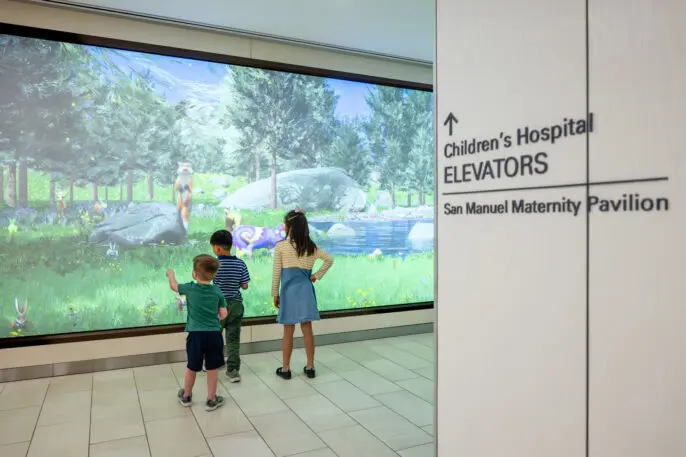
Webster explains that the interactive display was created using Unreal Engine, the 3D graphics system that underlies many video games. The system enables the characters within the scene to have unique interactions with their surroundings and the other creatures they encounter. Wind blows through their rainbow fur and the sun shines off their sunglasses. Two deer crossing paths will have one type of interaction, while a rabbit and a deer will have another. “So just by the sheer amount of people that come through and create different animals, you get different outcomes,” she says.
Funding for the project came from philanthropic sources who requested that their names, and the project’s budget, remain anonymous. The installation also follows accessibility guidelines for the screens and the content within them. They’re designed to be engaging for people across a range of physical and cognitive abilities, and also set in a natural scene in a nod to the healing benefits of biophilia.
The idea has caught some traction. About 300 animals are created every day, according to Bussell, adding up to more than 18,000 since the installation opened in November. Though the hospital doesn’t collect data from patients about how they’ve used Loma Land, Bussell says anecdotally that it’s been successful in reducing some of the strain and fear a visit to the hospital can create. “I’ve seen kids go from crying and stressed, mom’s holding their hand and they don’t want to be there, to interacting and having fun,” she says.
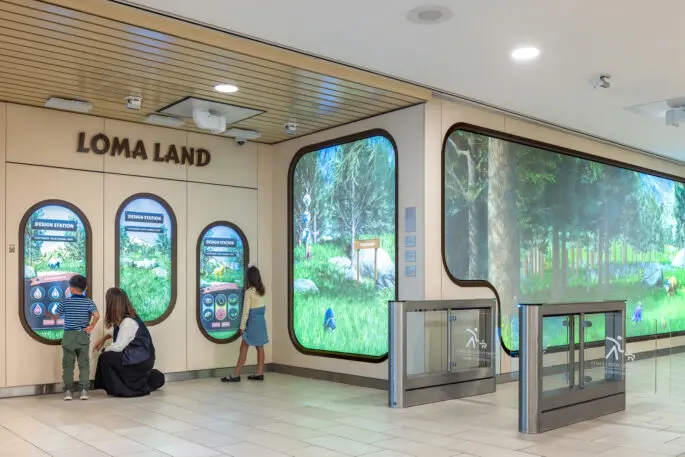
For Webster, that’s the goal of the project, and validation that this type of installation can work in other healthcare settings, serving other children, or adults, or even healthcare workers. “There’s a lot of opportunity to improve the day-to-day experience of people moving through a hospital and caring for the emotional wellbeing of the population,” she says.
And even though Loma Land was designed with children in mind, Bussell says that hasn’t stopped others from using it, including one clearly older visitor on a recent afternoon.
“I’m going to guess that the gentleman was probably mid 70s, and he was creating an animal,” Bussell says, recalling the smile on his face. “That wasn’t our target audience, but he’s going to remember that experience.”
Recognize your brand’s excellence by applying to this year’s Brands That Matter Awards before the final deadline, June 7.
Sign up for Brands That Matter notifications here.
